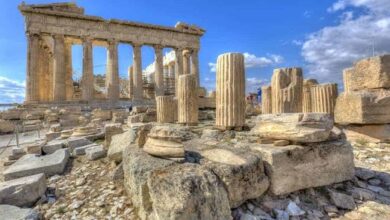What is Geyser origin Types Curiosities and examples
Geyser
“ Geyser ” is a term used to describe a hot spring that periodically erupts, spewing a column of hot water and water vapor into the air. It usually appears in places close to active volcanoes or that have a lot of underground heat. The word geyser derives from Geysir , the name of a spring located in Iceland. In Icelandic, geysir means to spurt.
A geyser is a vent in the Earth’s surface that periodically ejects a column of hot water and steam.
Even a small geyser is an incredible phenomenon; however, some geysers have eruptions that spew thousands of gallons of boiling water up to a few hundred feet into the air.
Old Faithful is the most famous geyser in the world. It is located in Yellowstone National Park (USA). Old Faithful erupts every 60 to 90 minutes and blasts a few thousand gallons of boiling water 100 to 200 feet into the air.
Geysers are extremely rare features. They only occur where there is a coincidence of unusual conditions. There are only about 1000 geysers in the world, and most of them are located in Yellowstone National Park (USA).
How does a geyser
come about?
A geyser forms when surface water seeps underground and comes into contact with extremely hot volcanic rocks . In this process, the water gradually heats up. When it reaches about 100 °C, the pressure increases and part of the water turns into steam. In the gaseous state, it occupies a volume 1500 times greater than in the liquid state, escaping out of the reservoirs. Afterwards, the pressure is relieved and the subsoil fills with water again, which vaporizes and gains strength for a new eruption.
The eruptions have different characteristics and occur in an indeterminate period of time. The pauses between them can last for minutes or years, while their lengths can range from seconds to hours. The height of the water and steam column ranges from one to 100 meters, and the amount of water discharged varies from a few liters to tens of thousands of liters.
It is noteworthy that the appearance of a geyser depends on several natural factors, such as quantity, temperature, distribution and movement of infiltrated waters and volcanic rocks. Therefore, the periodicity of this phenomenon is only maintained if the eruptions do not destroy the conditions for the next ones to occur.
Geyser – Types
fountain geysers
The fountain’s geysers shoot water in multiple directions. A fountain-type geyser has a large opening in the surface that normally fills with water before or during an eruption. Bubbles of steam rising through the pool during the eruption cause blasts of water that often spray in all directions. Fountain type geysers are the most common type of geyser and can range in size from very small to very large.
Cone Geysers
Cone geysers explode in a narrow jet of water, usually in the shape of a cone.
The plumbing system of a cone-type geyser usually has a narrow constriction near the geyser vent. During eruptions, the constriction acts like a nozzle, causing water to gush out in large columns. The cone is formed by the constant deposition of silica around the geyser vent.
As they travel underground through volcanic rhyolite, the thermal water dissolves the silica and transports it to the surface. Although some of the silica lines from the underground plumbing system, some can be deposited around the outside of a geyser to form a distinct cone. Splashes of silica-rich thermal water can also form bulbous “geyserite” masses.
The openings within these massive cones are usually very narrow, causing water to splash and spray when it emerges. Each splash and eruption adds its own increment of silica, enlarging the cones over the years. The cones of many of Yellowstone’s geysers are hundreds of years old.
Curiosities about Geyser
The Old Faithful geyser in Yellowstone spews hot water on a regular basis, specifically between 45 and 120 minutes and the water height rises to 50 meters. According to recent research, tremors are produced inside the earth and cause thermal activity.
Most geysers are normally found in volcanic areas and the best known are in Iceland, New Zealand, the United States, Japan and Chile. This phenomenon of nature represents an original attraction for thousands of tourists.
The Strokkur geyser in Iceland has an eruption frequency ranging between 5 and 10 minutes and its altitude reaches 20 meters. Geyser
The Maori people of New Zealand used the thermal waters near the geysers to cook food, as they understood that Mother Nature was the one to heat the products of the earth.
The energy geothermal geysers in territories where there is a natural resource that allows the use of ground water to get hot water in homes (this energy source is very common in countries like New Zealand, Japan and Iceland). Geyser
Before the hot water and steam jet comes out, there is a characteristic bubbling noise.
Examples of geysers
There are about a thousand geysers around the world. Yellowstone National Park in the United States comprises more than 300 of them. The majority of reported geysers are located in New Zealand, Iceland, Chile, Russia, Japan and the United States.
Old Faithful, located in Yellowstone National Park, is considered the most famous geyser in the world. It spouts approximately 45,000 liters of water per eruption – its column reaches a height of 52 meters. According to researchers, eruptions from this geyser occur at intervals of 37 minutes to an hour and 30 minutes. Each one lasts 2.5 minutes.
Another well-known example is Waimangu, located in New Zealand, which was once considered the most powerful geyser in the world. It spewed jets of water over 400 meters high. This geyser was extinguished in 1904, when a work changed the direction of the water flow. Today, only heated pools remain on site.


